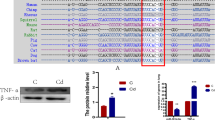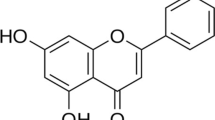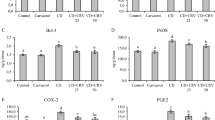Abstract
Cadmium (Cd), a toxic heavy metal, exists widely in the environment, which can enter organisms through a variety of ways and cause damage to various organs and tissues. However, the mechanism of lung toxicity in swine after Cd exposure is still unclear. To explore the molecular mechanism of swine lung damage caused by Cd exposure, we established the model of Cd exposure, and Cd chloride (20 mg/kg CdCl2) was added to the diet of swine for continuous exposure for 40 days. TUNEL staining showed that the apoptosis of swine lung increased significantly after Cd exposure. Meanwhile, the results of qRT-PCR showed that Cd induced oxidative stress and inhibited the expression of antioxidant enzymes including CAT, GCLM, GST, SOD, and GSH-px in lung tissue. Cd exposure activated mitochondrial apoptosis pathway via the TRAF2/ASK1/JNK signaling pathway. In brief, we considered that Cd exposure causes oxidative stress in lung and induces lung cell apoptosis through the TRAF2/ASK1/JNK pathway and increases the expression of HSPs to resist the toxicity of Cd. Our research enriches the theoretical basis of Cd toxicity and provides reference for comparative medicine.
Graphical abstract






Similar content being viewed by others
Data Availability
The datasets used and/or analyzed during the current study are available from the corresponding author upon reasonable request.
All the other authors have read the manuscript and have agreed to submit it in its current form for consideration for publication in the Journal.
References
Adokoh CK, Obodai EA, Essumang DK, Serfor-Armah Y, Nyarko BJ, Asabere-Ameyaw A (2011) Statistical evaluation of environmental contamination, distribution and source assessment of heavy metals (aluminum, arsenic, cadmium, and mercury) in some lagoons and an estuary along the coastal belt of Ghana. Arch Environ Contam Toxicol 61:389–400
Anderson CN, Tolkovsky AM (1999) A role for MAPK/ERK in sympathetic neuron survival: protection against a p53-dependent, JNK-independent induction of apoptosis by cytosine arabinoside. J Neurosci 19:664–673
Cai J, Guan H, Jiao X, Yang J, Chen X, Zhang H, Zheng Y, Zhu Y, Liu Q, Zhang Z (2021) NLRP3 inflammasome mediated pyroptosis is involved in cadmium exposure-induced neuroinflammation through the IL-1beta/IkB-alpha-NF-kappaB-NLRP3 feedback loop in swine. Toxicology 453:152720
Cannino G, Ferruggia E, Luparello C, Rinaldi AM (2009) Mitochondrial compartment: a possible target of cadmium effects on breast epithelial cells. Mol Cell Biochem 328:75–84
Chi QA, Hu XB, Zhao BA, Zhang QA, Zhang KA, Li SA (2020) Regulation of H2S-induced necroptosis and inflammation in broiler bursa of Fabricius by the miR-15b-5p/TGFBR3 axis and the involvement of oxidative stress in this process - ScienceDirect. J Hazard Mater 406:124682
Cho JH, Lee MK, Yoon KW, Lee J, Cho SG, Choi EJ (2012) Arginine methylation-dependent regulation of ASK1 signaling by PRMT1. Cell Death Differ 19:859–870
Davis SM, Pennypacker KR (2017) Targeting antioxidant enzyme expression as a therapeutic strategy for ischemic stroke. Neurochem Int 107:23–32
Dong N, Xu X, Xue C, Wang C, Shan A (2019) Ethyl pyruvate inhibits LPS induced IPEC-J2 inflammation and apoptosis through p38 and ERK1/2 pathways. Cell cycle (Georgetown, Tex) 18:1–15
Driscoll KE, Maurer JK, Poynter J, Higgins J, Asquith T, Miller NS (1992) Stimulation of rat alveolar macrophage fibronectin release in a cadmium chloride model of lung injury and fibrosis. Toxicol Appl Pharmacol 116:30
Fu B, Zhao J, Peng W, Wu H, Zhang Y (2017) Resveratrol rescues cadmium-induced mitochondrial injury by enhancing transcriptional regulation of PGC-1α and SOD2 via the Sirt3/FoxO3a pathway in TCMK-1 cells. Biochem Biophys Res Commun 486:198–204
Gabriele P, Natasha I, Mariapaola C, Giovanni P, Federica M, Vincenzo A, Francesco S, Domenica A, Alessandra B (2017) Oxidative stress: harms and benefits for human health. Oxid Med Cell Longev 2017:1–13
Gong ZG, Wang XY, Wang JH, Fan RF, Wang L (2018) Trehalose prevents cadmium-induced hepatotoxicity by blocking Nrf2 pathway, restoring autophagy and inhibiting apoptosis. J Inorg Biochem 192:62–71
Guo J, Xing H, Chen M, Wang W, Zhang H, Xu S (2019) H(2)S inhalation-induced energy metabolism disturbance is involved in LPS mediated hepatocyte apoptosis through mitochondrial pathway. Sci Total Environ 663:380–386
Han Q, Zhang J, Sun Q, Xu Y, Teng X (2020) Oxidative stress and mitochondrial dysfunction involved in ammonia-induced nephrocyte necroptosis in chickens. Ecotoxicol Environ Saf 203:110974
Hatai T, Matsuzawa A, Inoshita S, Mochida Y, Kuroda T, Sakamaki K, Kuida K, Yonehara S, Ichijo H, Takeda K (2000) Execution of apoptosis signal-regulating kinase 1 (ASK1)-induced apoptosis by the mitochondria-dependent caspase activation. J Biol Chem 275:26576–26581
Hung JJ, Cheng TJ, Lai YK, Chang MD (1998) Differential activation of p38 mitogen-activated protein kinase and extracellular signal-regulated protein kinases confers cadmium-induced HSP70 expression in 9L rat brain tumor cells. J Biol Chem 273:31924–31931
Ichijo H, Nishida E, Irie K, ten Dijke P, Saitoh M, Moriguchi T, Takagi M, Matsumoto K, Miyazono K, Gotoh Y (1997) Induction of apoptosis by ASK1, a mammalian MAPKKK that activates SAPK/JNK and p38 signaling pathways. Science 275:90–94
Ji M, Niu S, Guo J, Mi H, Jiang P (2020) Silencing RNF13 alleviates mice models with Parkinson’s disease via regulating endoplasmic reticulum stress-mediated IRE1α-TRAF2-ASK1-JNK pathway. J Mol Neurosci 70:199
Jin T, Wu X, Tang Y, Nordberg M, Bernard A, Ye T, Kong Q, Lundström NG, Nordberg GF (2004) Environmental epidemiological study and estimation of benchmark dose for renal dysfunction in a cadmium-polluted area in China. Biometals 17:525–530
Kirchhoff SR, Gupta S, Knowlton AA (2002) Cytosolic heat shock protein 60, apoptosis, and myocardial injury. Circulation 105:2899–2904
Kratimenos P, Koutroulis I, Agarwal B, Theocharis S, Delivoria-Papadopoulos M (2017) Effect of Src Kinase inhibition on Cytochrome c, Smac/DIABLO and apoptosis inducing factor (AIF) following cerebral hypoxia-ischemia in newborn piglets. Sci Rep 7:16664
Kundu S, Sengupta S, Chatterjee S, Mitra S, Bhattacharyya A (2009) Cadmium induces lung inflammation independent of lung cell proliferation: a molecular approach. J Inflamm 6:19
Lag M, Westly S, Lerstad T, Bjørnsrud C, Refsnes M, Schwarze PE (2002) Cadmium-induced apoptosis of primary epithelial lung cells: involvement of Bax and p53, but not of oxidative stress. Cell Biol Toxicol 18:29–42
Liu G, Wang ZK, Wang ZY, Yang DB, Liu ZP, Wang L (2016) Mitochondrial permeability transition and its regulatory components are implicated in apoptosis of primary cultures of rat proximal tubular cells exposed to lead. Arch Toxicol 90:1193–1209
Liu Q, Wang W, Zhang Y, Cui Y, Li S (2020) Bisphenol A regulates cytochrome P450 1B1 through miR-27b-3p and induces carp lymphocyte oxidative stress leading to apoptosis. Fish Shellfish Immunol 102:10
Lywab C, Rffab C, Dbyab C, Dong ZD, Lin W (2019) Puerarin reverses cadmium-induced lysosomal dysfunction in primary rat proximal tubular cells via inhibiting Nrf2 pathway. Biochem Pharmacol 162:132–141
Matsuzawa A, Ichijo H (2001) Molecular mechanisms of the decision between life and death: regulation of apoptosis by apoptosis signal-regulating kinase 1. J Biochem 130:1–8
McArthur K, Whitehead LW, Heddleston JM, Padman BS, Oorschot V, Geoghegan ND, Chappaz S, Davidson S, San Chin H, Lane RM, Dramicanin M, Saunders TL, Sugiana C, Lessene R, Osellame LD, Chew TL, Dewson G, Lazarou M, Ramm G, Lessene G, Ryan MT, Rogers KL, van Delft MF, Kile BT (2018) BAK/BAX macropores facilitate mitochondrial herniation and mtDNA efflux during apoptosis. Science 359(6378):eaao6047
Nishitoh H, Matsuzawa A, Tobiume K, Saegusa K, Takeda K, Inoue K, Hori S, Kakizuka A, Ichijo H (2002) ASK1 is essential for endoplasmic reticulum stress-induced neuronal cell death triggered by expanded polyglutamine repeats. Genes Dev 16:1345–1355
Nishitoh H, Saitoh M, Mochida Y, Takeda K, Nakano H, Rothe M, Miyazono K, Ichijo H (1998) ASK1 is essential for JNK/SAPK activation by TRAF2. Mol Cell 2:389–395
Noguchi T, Takeda K, Matsuzawa A, Saegusa K, Ichijo H (2005a) Recruitment of TRAF family proteins to the ASK1 signalosome is essential for oxidative stress-induced cell death. J Biol Chem
Noguchi T, Takeda K, Matsuzawa A, Saegusa K, Nakano H, Gohda J, Inoue J, Ichijo H (2005) Recruitment of tumor necrosis factor receptor-associated factor family proteins to apoptosis signal-regulating kinase 1 signalosome is essential for oxidative stress-induced cell death. J Biol Chem 280:37033–37040
Osman W, El-Samad LM, el Mokhamer H, El-Touhamy A, Shonouda M (2015) Ecological, morphological, and histological studies on Blaps polycresta (Coleoptera: Tenebrionidae) as biomonitors of cadmium soil pollution. Environ Sci Pollut Res Int 22:14104–14115
Pari L, Murugavel P, Sitasawad SL, Kumar KS (2007) Cytoprotective and antioxidant role of diallyl tetrasulfide on cadmium induced renal injury: an in vivo and in vitro study. Life ences 80:650–658
Phillips CJC, Chiy PC, Omed HM (2004) The effects of cadmium in feed, and its amelioration with zinc, on element balances in sheep. J Anim 82:2489
Poliandri AH, Cabilla JP, Velardez MO, Bodo CC, Duvilanski BH (2003) Cadmium induces apoptosis in anterior pituitary cells that can be reversed by treatment with antioxidants. Toxicol Appl Pharmacol 190:17–24
Qu KC, Wang ZY, Tang KK, Zhu YS, Fan RF (2019) Trehalose suppresses cadmium-activated Nrf2 signaling pathway to protect against spleen injury. Ecotoxicol Environ Saf 181:224–230
Seid Alian N, Khodarahmi P, Naseh V (2018) The Effect of cadmium on apoptotic genes mRNA expression of Bax and Bcl-2 in small intestine of rats. Iran J Pathol 13:408–414
Shih CM, Wu JS, Ko WC, Wang LF, Wei YH, Liang HF, Chen YC, Chen CT (2003) Mitochondria-mediated caspase-independent apoptosis induced by cadmium in normal human lung cells. J Cell Biochem 89:335–347
Shimoda R, Achanzar WE, Qu W, Nagamine T, Takagi H, Mori M, Waalkes MP (2003) Metallothionein is a potential negative regulator of apoptosis. Toxicol Sci 73:294–300
Thiab NR, King N, Jones GL (2015) Effect of ageing and oxidative stress on antioxidant enzyme activity in different regions of the rat kidney. Mol Cell Biochem 408:253–260
Tobiume K, Matsuzawa A, Takahashi T, Nishitoh H, Morita K, Takeda K, Minowa O, Miyazono K, Noda T, Ichijo H (2001) ASK1 is required for sustained activations of JNK/p38 MAP kinases and apoptosis. EMBO Rep 2:222–228
Wang C, Nie G, Yang F, Chen J, Zhang C (2019) Molybdenum and cadmium co-induce oxidative stress and apoptosis through mitochondria-mediated pathway in duck renal tubular epithelial cells. J Hazard Mater 383:121157
Wang L, Wang L, Shi X, Xu S (2020) Chlorpyrifos induces the apoptosis and necroptosis of L8824 cells through the ROS/PTEN/PI3K/AKT axis. J Hazard Mater 398:122905
Wang MG, Li WH, Wang XY, Yang DB, Wang ZY, Wang L (2017) CaMKII is involved in subcellular Ca2 + redistribution-induced endoplasmic reticulum stress leading to apoptosis in primary cultures of rat proximal tubular cells exposed to lead. Oncotarget 8:91162–91173
Wang S, Li X, Wang W, Zhang H, Xu S (2019) Application of transcriptome analysis: Oxidative stress, inflammation and microtubule activity disorder caused by ammonia exposure may be the primary factors of intestinal microvilli deficiency in chicken. Sci Total Environ 696:134035
Wang S, Wang W, Li X, Zhao X, Wang Y, Zhang H, Xu S (2020) Cooperative application of transcriptomics and ceRNA hypothesis: LncRNA-107052630/miR-205a/G0S2 crosstalk is involved in ammonia-induced intestinal apoptotic injury in chicken. J Hazard Mater 396:122605
Wang W, Liu Q, Zhang T, Chen L, Li S, Xu S (2020) Glyphosate induces lymphocyte cell dysfunction and apoptosis via regulation of miR-203 targeting of PIK3R1 in common carp (Cyprinus carpio L.). Fish Shellfish Immunol 101:51–57
Wang W, Shi Q, Wang S, Zhang H, Xu S (2020) Ammonia regulates chicken tracheal cell necroptosis via the LncRNA-107053293/MiR-148a-3p/FAF1 axis. J Hazard Mater 386:121626
Wang Y, Zhao H, Mu M, Guo M, Xing M (2020) Zinc offers splenic protection through suppressing PERK/IRE1-driven apoptosis pathway in common carp (Cyprinus carpio) under arsenic stress. Ecotoxicol Environ Saf 208:111473
William A, Nasir M, Shafiee C, Chapman V, Metzler M, Jad A (2017) Corrigendum: Expression of NAD(P)H quinone dehydrogenase 1 (NQO1) is increased in the endometrium of women with endometrial cancer and women with polycystic ovary syndrome. Clin Endocrinol 87:886–886
Wongmekiat O, Peerapanyasut W, Kobroob A (2018) Catechin supplementation prevents kidney damage in rats repeatedly exposed to cadmium through mitochondrial protection. Naunyn Schmiedebergs Arch Pharmacol 391:385–394
Wu X, Wei S, Wei Y, Guo B, Yang M, Zhao D, Liu X, Cai X (2012) The reference dose for subchronic exposure of pigs to cadmium leading to early renal damage by benchmark dose method. Toxicol Sci 128:524–531
Xanthoudakis S, Roy S, Rasper D, Hennessey T, Aubin Y, Cassady R, Tawa P, Ruel R, Rosen A, Nicholson DW (1999) Hsp60 accelerates the maturation of pro-caspase-3 by upstream activator proteases during apoptosis. EMBO J 18:2049–2056
Xie P (2013) TRAF molecules in cell signaling and in human diseases. J Mol Signaling 8:7
Xu DP, Li Y, Meng X, Zhou T, Zhou Y, Zheng J, Zhang J.J, Li HB (2017) Natural antioxidants in foods and medicinal plants: extraction, assessment and resources. Int J Mol Sci 18:96
Yang J, Gong Y, Cai J, Liu Q, Zhang Z (2019) lnc-3215 suppression leads to calcium overload in selenium deficiency-induced chicken heart lesion via the lnc-3215-miR-1594-TNN2 pathway. Mol Ther Nucl Acids 18:1–15
Yang J, Liu H, Li L, Liu H, Shi W, Yuan X, Wu L (2016) Structural insights into IRE1 functions in the unfolded protein response. Curr Med Chem 23:4706–4716
Yang J, Shi G, Gong Y, Cai J, Zheng Y, Zhang Z (2020) LncRNA 0003250 accelerates heart autophagy and binds to miR-17–5p as a competitive endogenous RNA in chicken induced by selenium deficiency. J Cell Physiol 236:157–177
Yang Y, Yu Y, Wang J, Li Y, Li Y, Wei J, Zheng T, Jin M, Sun Z (2017) Silica nanoparticles induced intrinsic apoptosis in neuroblastoma SH-SY5Y cells via CytC/Apaf-1 pathway. Environ Toxicol Pharmacol 52:161–169
Yao Y, Wang Y, Zhang Y, Liu C (2017) Klotho ameliorates oxidized low density lipoprotein (ox-LDL)-induced oxidative stress via regulating LOX-1 and PI3K/Akt/eNOS pathways. Lipids Health Dis 16:77
Yuan Y, Jiang CY, Xu H, Sun Y, Hu FF, Bian JC, Liu XZ, Gu JH, Liu ZP (2013) Cadmium-induced apoptosis in primary rat cerebral cortical neurons culture is mediated by a calcium signaling pathway. PLoS One 8:e64330
Zhang W, Wu T, Zhang C, Luo L, Xie M, Huang H (2017) Cadmium exposure in newborn rats ovary induces developmental disorders of primordial follicles and the differential expression of SCF/c-kit gene. Toxicol Lett 280:20–28
Zhang Y, Liu Q, Yin H, Li S (2020) Cadmium exposure induces pyroptosis of lymphocytes in carp pronephros and spleens by activating NLRP3. Ecotoxicol Environ Saf 202:110903
Zhang Y, Yin H, Shao B, Xue H, Li S (2021) Antagonistic effect of VDR/CREB1 pathway on cadmium-induced apoptosis in porcine spleen. Ecotoxicol Environ Saf 209:111819
Zhao H, Liu W, Wang Y, Dai N, Gu J, Yuan Y, Liu X, Bian J, Liu ZP (2015) Cadmium induces apoptosis in primary rat osteoblasts through caspase and mitogen-activated protein kinase pathways. J Vet Sci 16:297–306
Zhao H, Wang Y, Liu J, Guo M, Fei D, Yu H, Xing M (2019) The cardiotoxicity of the common carp (Cyprinus carpio) exposed to environmentally relevant concentrations of arsenic and subsequently relieved by zinc supplementation. Environ Pollut 253:741–748
Zhao Y, Li ZF, Zhang D, Wang ZY, Wang L (2021) Quercetin alleviates cadmium-induced autophagy inhibition via TFEB-dependent lysosomal restoration in primary proximal tubular cells. Ecotoxicol Environ Saf 208:111743
Zheng S, Wang S, Zhang Q, Zhang Z, Xu S (2019) Avermectin inhibits neutrophil extracellular traps release by activating PTEN demethylation to negatively regulate the PI3K-ERK pathway and reducing respiratory burst in carp. J Hazard Mater 389:121885
Zhuang J, Nie G, Yang F, Cao H, Xing C, Dai X, Hu G, Zhang C (2019) Molybdenum and Cadmium co-induced the levels of autophagy-related genes via adenosine 5’-monophosphate-activated protein kinase/mammalian target of rapamycin signaling pathway in Shaoxing Duck (Anas platyrhyncha) kidney. Poult Sci 98:6533–6541
Zygula A, Kosinski P, Zwierzchowska A, Sochacka M, Wroczynski P, Makarewicz-Wujec M, Pietrzak B, Wielgos M, Rzentala M, Giebultowicz J (2019) Oxidative stress markers in saliva and plasma differ between diet-controlled and insulin-controlled gestational diabetes mellitus. Diabetes Res Clin Pract 148:72–80
Acknowledgements
The authors extend their sincere thanks to the members of the veterinary internal medicine laboratory and key Laboratory for Laboratory Animals at the College of Veterinary Medicine, Northeast Agricultural University.
Funding
This study was supported by China Agriculture Research System of MOF and MARA.
Author information
Authors and Affiliations
Corresponding author
Additional information
Publisher’s Note
Springer Nature remains neutral with regard to jurisdictional claims in published maps and institutional affiliations.
Rights and permissions
About this article
Cite this article
Zhang, J., Zhang, Y., Qi, X. et al. TRAF2/ASK1/JNK Signaling Pathway Is Involved in the Lung Apoptosis of Swine Induced by Cadmium Exposure. Biol Trace Elem Res 200, 2758–2766 (2022). https://doi.org/10.1007/s12011-021-02860-6
Received:
Accepted:
Published:
Issue Date:
DOI: https://doi.org/10.1007/s12011-021-02860-6




